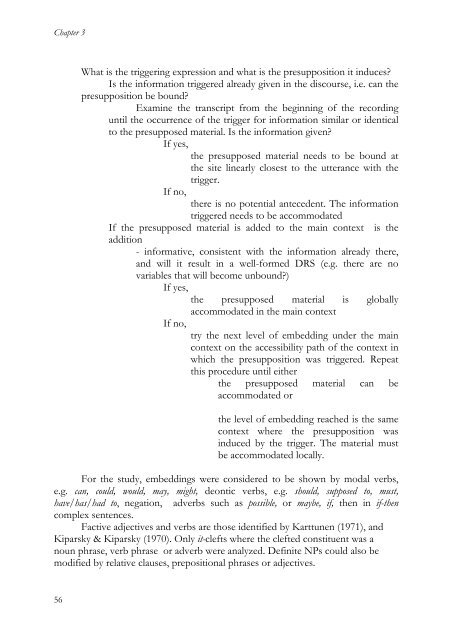Presuppositions in Spoken Discourse
Presuppositions in Spoken Discourse
Presuppositions in Spoken Discourse
Create successful ePaper yourself
Turn your PDF publications into a flip-book with our unique Google optimized e-Paper software.
Chapter 3<br />
56<br />
What is the trigger<strong>in</strong>g expression and what is the presupposition it <strong>in</strong>duces?<br />
Is the <strong>in</strong>formation triggered already given <strong>in</strong> the discourse, i.e. can the<br />
presupposition be bound?<br />
Exam<strong>in</strong>e the transcript from the beg<strong>in</strong>n<strong>in</strong>g of the record<strong>in</strong>g<br />
until the occurrence of the trigger for <strong>in</strong>formation similar or identical<br />
to the presupposed material. Is the <strong>in</strong>formation given?<br />
If yes,<br />
the presupposed material needs to be bound at<br />
the site l<strong>in</strong>early closest to the utterance with the<br />
trigger.<br />
If no,<br />
there is no potential antecedent. The <strong>in</strong>formation<br />
triggered needs to be accommodated<br />
If the presupposed material is added to the ma<strong>in</strong> context is the<br />
addition<br />
- <strong>in</strong>formative, consistent with the <strong>in</strong>formation already there,<br />
and will it result <strong>in</strong> a well-formed DRS (e.g. there are no<br />
variables that will become unbound?)<br />
If yes,<br />
the presupposed material is globally<br />
accommodated <strong>in</strong> the ma<strong>in</strong> context<br />
If no,<br />
try the next level of embedd<strong>in</strong>g under the ma<strong>in</strong><br />
context on the accessibility path of the context <strong>in</strong><br />
which the presupposition was triggered. Repeat<br />
this procedure until either<br />
the presupposed material can be<br />
accommodated or<br />
the level of embedd<strong>in</strong>g reached is the same<br />
context where the presupposition was<br />
<strong>in</strong>duced by the trigger. The material must<br />
be accommodated locally.<br />
For the study, embedd<strong>in</strong>gs were considered to be shown by modal verbs,<br />
e.g. can, could, would, may, might, deontic verbs, e.g. should, supposed to, must,<br />
have/has/had to, negation, adverbs such as possible, or maybe, if, then <strong>in</strong> if-then<br />
complex sentences.<br />
Factive adjectives and verbs are those identified by Karttunen (1971), and<br />
Kiparsky & Kiparsky (1970). Only it-clefts where the clefted constituent was a<br />
noun phrase, verb phrase or adverb were analyzed. Def<strong>in</strong>ite NPs could also be<br />
modified by relative clauses, prepositional phrases or adjectives.











